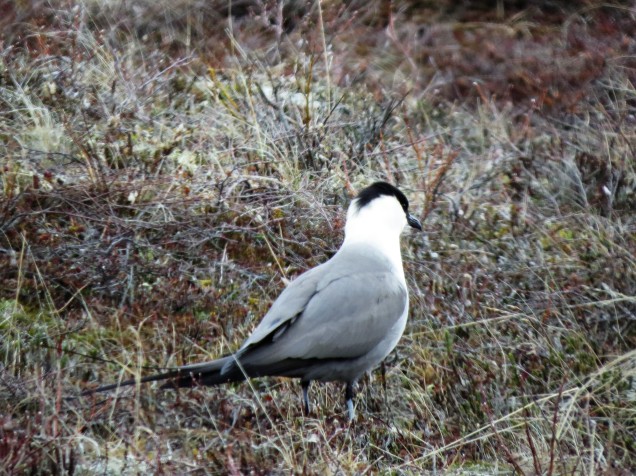This blog post will show what it looked like as I drove around looking for birds during my recent trip to Nome. Because I took so many photos (about 4000 in 5 days), it is taking awhile to go through them all. I will try to be somewhat selective and will not show them all (my vast selection of scene photos below really is a tiny subgroup of the whole). I will cover birds and animals in my next blog posts, hopefully later today and tomorrow, but possibly after that.
It was clear to me as our flight arrived in the Nome area on May 22nd that it still was a cold world down there.

Most days while I was in Nome the temperature stayed just above freezing, with the temperatures mostly hovering about 34-39 degrees, only getting above forty degrees by late afternoon a couple of days. The last day it was mostly just at 32 degrees most of the day. There was some melting occurring, and probably the snow was also subliming (I think that’s the word) while I was there, and the snow and ice gradually decreased, especially near the coast. Many of the ponds and lakes were still partially or fully frozen over and some smaller streams still flowed beneath the snow, but grassy and rocky areas were cleared or clearing and the larger rivers were mostly open except along some of the edges. Salmon Lake was still completely frozen over. The ocean itself was mostly cleared of ice except for periodic small bergs drifting by and ice covering small bays and some shorelines. Except in the mountains on my last day, it did not snow (or rain) on me for the whole trip. It varied from sunny to cloudy, usually with a moderate to strong wind.
The road crews were out removing snow, but by the end of the trip I was still never able to travel the full length of the roads. Of the three main roads, I was able to go about 50 miles out on Council and Kougarok Roads (of the over 70 miles of road for each) and about 63 miles on Teller Road (of the 71 miles of road stretching from Nome to Teller), before I was halted by impassable roads. Many areas that I did drive through were mucky, icy, slushy, and/or slippery muddy, but I was finally stopped in each case by extensive areas of increasingly hard-to-drive road surfaces, where I slid and oozed my way slowly along the roads. In the case of Teller Road it snowed a bit on my drive out there on May 26th and I was stopped by snow banks still over the road that were being slowly cleared by a bulldozer. If it had been urgent, I probably could have gone farther, except on Teller Road, where no one had yet gone through since the most recent snow/drifting. I will plan to do the full drives on my next trips to Nome in early June and July.
Below are sample scenes showing the terrain and the extent of snow and ice cover during these days. The photo groups are in chronological order and are not individually labeled as to the particular road. They are grouped generally by date.
Tuesday, May 22, evening after my flight arrived in early evening, Council Road:
Wednesday, May 23, Teller in morning and then Council Road to the mostly frozen over Safety Sound:
Thursday, May 24, Council Road most of day; short drive up Kougarok Road in early evening:
Friday, May 25, Kougarok Road most of day; short drive on Council Road to Safety Sound in early evening:
Saturday, May 26, Teller Road most of day; very short drive on Council Road before my flight in the evening:
Please note: the last picture above is of a car that is hanging off the edge of the road and is NOT my car , but shows what can happen if you don’t pay attention to the road conditions.
I will be back to Nome very soon, participating in a Wilderness Birding Adventures trip there from June 1-4 and staying to do some more exploring from June 5-7.
































































































































































































































































